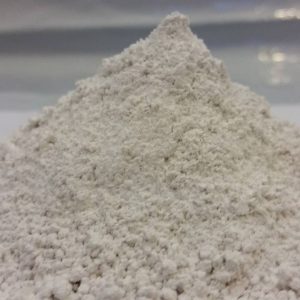As someone who gardens and grows vegetables on a heavy clay soil with a solid brown clay sub-soil, I am always interested in ways to improve this soil.
Using gypsum not only results in better crops but less work in digging over to avoid compaction each year as it improves the quality of the soil.
Do you have clay or layer of hard subsoil problems in your garden?
Then gypsum may be the answer to help loosen the soil structure. It is not considered a miracle substance and you will find that it doesn’t work right away, but a 3 year program of applications should help improve the poor soil conditions.
It is not expensive and is easy to spread where needed.
Gypsum also has a job of repairing the soil that has been damaged through compaction from heavy stock, machinery, in the recovery of sub-soils exposed by earth movement and in soils affected by salinity.
A gardener faces one of the biggest problems in a new or established garden if they have a clay or layer of hard subsoil type of soil. This type of soil creates poor drainage, soggy soil and soil compaction.
When you have a new garden you can work organic humus, which should be done anyway, to loosen the poor soil. Manure, compost, peat moss and soil mulches and conditioners are normally used for this purpose.
You might ask, what do you do in an established garden? A lot of work and time to recondition soil would be required. Gypsum may be just the answer for reconditioning the soil, because it can be spread on the surface of the soil like in the vegetable garden, flowerbeds or on the lawn. What this means is it does not have to be worked into the soil, it can just simply be spread on the surface.
Gypsum as a Soil Improver
What does Gypsum do? It’s main purpose is to make the small particles in clay soil flocculate (join together) into larger particles like that of a sandy soil which enables better water penetration and retention as well as better root penetration. This also enables better nutrient use by the plants.
Nutrient value of Gypsum Fertiliser
Be aware that gypsum does not contain any major plant nutrients, so continue a regular fertilizing program even though it contains calcium and sulphur which is needed for plant growth. In addition, continue to put out organic humus as you plant.
Gypsum is easy to apply
Just spread it on the lawn, using the granular type, with a lawn spreader at the rate of 40 pounds per thousand square feet. Gypsum fertilizer can be spread any time of the year and only one application per year is needed. To get it started working, water immediately after applying. If applied properly it does not affect the pH of the soil, not harmful to humans and your animals and will not burn.
Because Gypsum is neutral and will not change the soil pH, you can use it in places where plants like Azaleas, Camellias, Rhododendrons and other acid loving plants grow, they need a little calcium too. Of course, gypsum should be applied per directions.
What is gypsum?
Gypsum is a naturally occurring mineral which is best known in the UK as being the main constituent in plaster. It’s chemical name is calcium sulfate dihydrate ( CaSO4·2H2O)
About the Author
James Ellison is a long time organic gardening enthusiast and writes articles based on intensive research, lectures from professionals, gardening books and just plain common sense.




